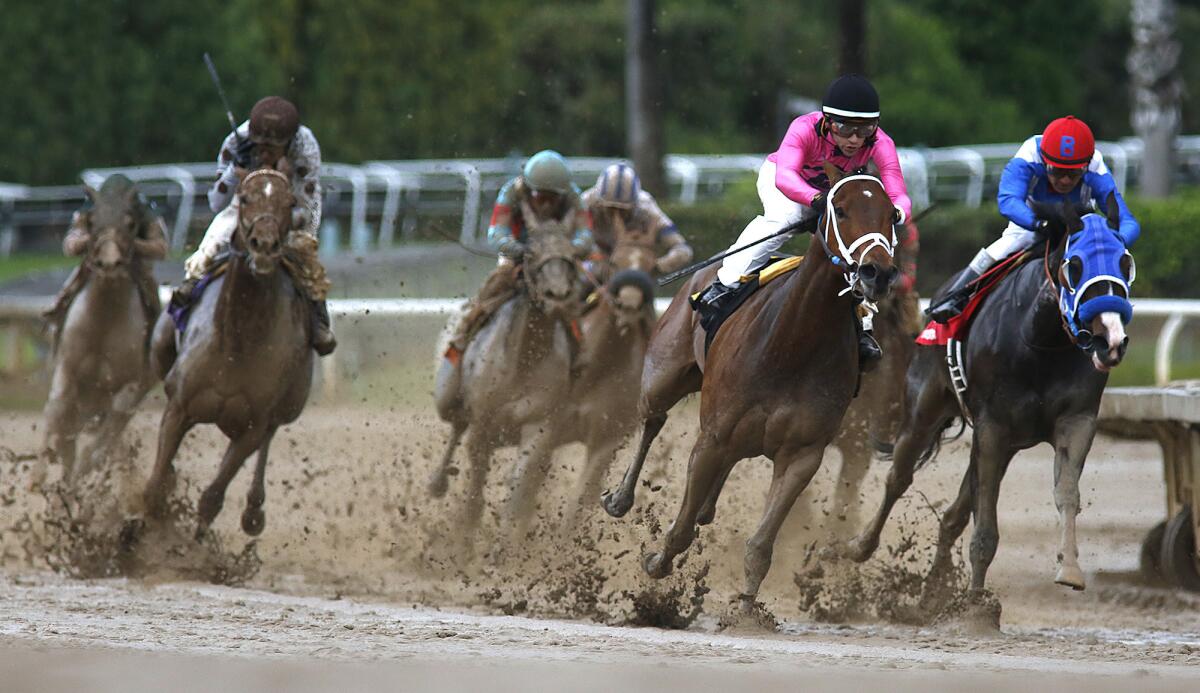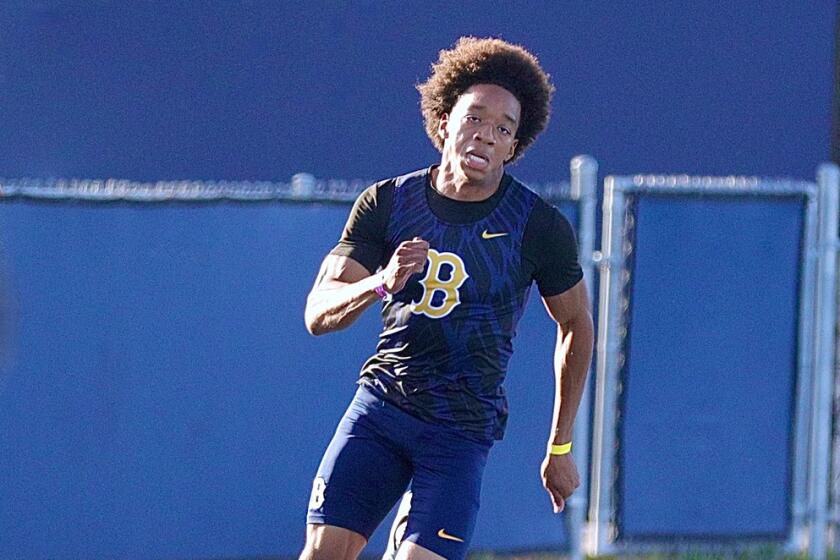Somehow, in horse racing, the show (bet) still goes on

- Share via
Even the smartest people sometimes get their wisdom from strange places.
Take Jon White, a horse racing encyclopedia, who doubles as the morning-line oddsmaker at Santa Anita.
He cites a 1975 television episode of the “The Odd Couple,” a show based on a Neil Simon play about a sportswriter/gambler named Oscar and his lifelong friend and polar opposite, Felix.
“Felix and Oscar go to the races,” White recalls. “And Oscar tells Felix he can make a show bet and his horse only has to finish in the top three.”
“So Felix says, ‘You mean you can bet on a horse and he can lose the race and you can still win money? And you’ve been losing money all these years?’”
Therein lies the magic and mystery of one of the most misunderstood wagers: the show bet.
Lately, this low-risk, low-reward bet is in serious need of a makeover. If it were at a family gathering, it would be the crazy uncle or the hideous Christmas sweater your grandma made for you to wear.
“With today’s mind-set to hit the lottery, the show wager is really something of a dinosaur,” White said.
At Santa Anita last year, only 4.5% of the total handle was bet to show. Compare that to 6.7% for place and 21.0% for win. Single race exotics (exactas, trifectas, etc.) account for 40.1% of the wagers and multi-race bets (doubles, pick-three, etc.) are good for 27.7%.
Marketing the bet
Santa Anita, which opens its signature winter/spring meeting Monday, is banking on at least modest interest in show betting to help bring new fans to the sport.
It’s a game called “ShowVivor.” It has been around a couple years but Santa Anita has made revisions. It’s free and offers $5,000 in prize money, sliced in many different forms, such as longest show streak, number of wins and places and largest payoff.
You enter through the website (santaanita.com/showvivor), so you know the track is trading a little cash to know more about its customers.
“From a marketing standpoint, you have to go to the website every day,” said Nate Newby, Santa Anita’s vice president of marketing. “[The contest] is a perfect combination, because it sounds easy picking one show horse every day. But it’s also tougher than you think. … It’s almost like a show plunge. If that horse loses, a lot of people get eliminated.”
The track hopes show bets are really gateway wagers.
“We’ve seen it with our Wagering Ambassadors [staffers who help new bettors],” Newby said. “They recommend show bets for the first couple of days and then people come back and say, ‘I want to make more money.’
“For some, the transformation can only take a few hours, because some go from show bets to trifecta bets on their first day.”
The good old days
There are a couple of reasons for the decline of show wagering over the years, mostly tied to the health of the racing business. “What killed show wagering are the short fields, five-horse races,” said Brad McKinzie, vice president and general manager of the Los Alamitos Racing Assn.
“Today a show bet can pay $2.10 or $2.20. In the days with full fields, you could bet a horse that was first or second favorite and get $3.20.”
A fun game for novices is the show parlay, where you take all the money you won on one race and just keep adding it to wagers you make in each subsequent race.
“The example I use is my mom,” McKinzie said. “She would come here with some friends and they would do a show parlay. They would each throw in 10 bucks and would bet the favorite to show. By the last race they would have 400 or 500 bucks because they were doubling their money a lot. Now they get $2.20 and there is no return.
“With short fields I don’t even know why people bet show wagering.”
Another reason for the decline is the size of the betting menu.
White happened to have a 1977 Santa Anita program.
“The entire betting menu was win, place and show,” White said. “One $2 double on the first and second race and a $5 exacta on three races. That was it. It’s like night and day compared to today.”
White pointed out that the minimum bet in 1977 was $2 and today there are 10-cent superfectas and other micro-wagers. “The wagering competition has certainly cost show wagering its popularity,” he said.
Beating the system
Adding to the intrigue of this wager is the polarity of the bets. People seem to bet either $2 or $10,000 to show. There’s not much of a middle market.
The theory behind an excessively large wager is that most tracks are required to return no less than 5% on any bet. So if there is too much money placed on one horse, the track can actually lose money by virtue of the mandatory 5% payout.
Last week at Los Alamitos, the track did not have show or place wagering in the race won by California Chrome. In the win pool, 88% of all bets were on Chrome, creating a minus pool of just short of $60,000.
The term for people making these large bets are bridge jumpers.
“If we had show wagering on this race, there would be so many bridge jumpers there wouldn’t be any room left on the bridge,” McKinzie said.
If you lose one race by having the favorite run out of the money, you have to win the next 20 races to break even.
“I don’t understand it myself, why someone would risk a lot of money to win very little money,” said Bob Mieszerski, who has been a handicapper for 38 years, including at The Times and at the Los Angeles Newspaper Group.
There are three tracks that are considered the holy trinity of bridge jumping: Charles Town and Mountaineer in West Virginia and Prairie Meadows in Iowa. Their minimum payout is 10%, or $2.20.
Jay Kornegay, vice president of race and sports operations at the Westgate Las Vegas, limits large show wagers at those tracks because in many instances the property that takes the bet is responsible for paying it.
“If it’s a VIP, we’ll let them bet a couple thousand dollars,” Kornegay said. “If it’s someone that comes in three to five days a week, we might limit them to $1,000 or $500 or less. Others we make not take the bet at all.”
Kornegay has had a front-row seat for the deterioration of pari-mutuel wagering.
“When I entered the gaming industry in the late ‘80s, we were doing 70% of our business in the race book and 30% on sports,” he said. “Now it’s been a complete flip flop with 70% now on sports and 30% on racing.”
Beating the beaters
The riskiness of bridge jumping has created a group of people whose goal is to beat them.
About eight years ago, Stuart Slagle had an idea to put together a communications network to let bettors know when there are show plunges or potential minus pools. But the objective was the opposite. It was hoping the favorite ran out of the money producing big payoffs.
Slagle, now the racing secretary at Woodbine Racetrack in Toronto, is now more of an absentee landlord on the site to avoid any conflicts with his job.
“There’s an old saw that it’s better to use small money to make big money than use big money to make small money,” Slagle said. “It’s more impressive when someone uses $200 to win a Pick 6 as opposed to spending $10,000 to make $200.”
Bob Ike, a handicapper in Southern California for more than 30 years, is one of those that tries to beat the beaters.
“It’s such a dumb bet for people to be making,” Ike said of the plungers. “I get a thrill when I take them on, be the contrarian, and then get a lot of pleasure when they run out.”
Ike said he will bet about $100 on those races and generally loses no more than 20% or 30%. But when they hit …
“I’ve gotten back as much as $2,000 on that investment,” Ike said, citing when heavy favorite Shared Belief ran out of the money in Charles Town.
Looking out for the bettors
While it’s naive to think the track looks out for the bettors first, there is one person who has continually resisted the idea of eliminating show wagering to save the track money.
Joe Morris, senior vice president for West Coast operations of the Stronach Group, is essentially the general manager of Santa Anita and Golden Gate.
The spectacular 3-year-old filly Songbird ran four times at Santa Anita this year and each time produced a minus pool. Even when there was a five-horse field in the Summertime Oaks, Morris declined to kill the show pool.
However, when Songbird spent part of the summer in New York at Saratoga, the track suspended show wagering in both races with fields of seven and five.
“Songbird is the draw,” Morris said. “And then to take the big draw and tell newcomers they can’t make a bet on her is not a good decision. … We’re in the wagering business, so it should be difficult to a make a decision to not take a wager.”
The exposure the tracks feel is greatly overstated. Santa Anita, for example, is only responsible for what paying out what is bet on track and other Southern California satellite operations. In addition, there is a split with the Thoroughbred Owners of California (TOC).
And let’s not forget about the 15% takeout the track gets on top of every show bet made. “When you look at the 15% of our wagers that are actually made on track, there is a lot of ways to spread the money out,” Morris said.
There is agreement
Everyone agrees that the show bet is not going anywhere. It might not bring a lot of value, but it’s also not hurting anything either.
“I think they should always keep it,” Mieszerski said. “I have no problems with it, even though I’ve never participated in it. And that goes back to when there were no exactas. It’s a good thing for people who are novices. It’s a way to cash tickets.”
McKinzie also wants to keep it around.
“The only reason to do away with it is if you thought the money was going into another pool,” McKinzie said. “But I don’t think that’s the case.”
Veteran patrons, used to the days without exotics, were known for the call, “five across,’’ betting five dollars to win, place and show.
It’s also true that the show bet doesn’t bring a lot more safety than a win bet.
“When a favorite gets beat, it doesn’t mean they have to finish, second or third,” White said. “Yes, California Chrome won by 12 lengths, but in horse racing anything can happen. There is usually one way to win a race and 1,000 ways to lose to race.”
And even more ways to lose a bet.
More to Read
Go beyond the scoreboard
Get the latest on L.A.'s teams in the daily Sports Report newsletter.
You may occasionally receive promotional content from the Los Angeles Times.











